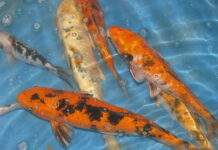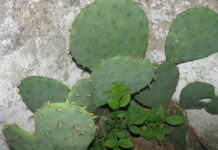Photo credit: DiasporaEngager (www.DiasporaEngager.com).
Results
Acute Flaccid Paralysis
Surveillance indicators and detected cases were assessed in 28 priority countries during 2022–2023 (Table 1). Priority countries include 21 in the African region, five in the Eastern Mediterranean region, and one each in the South-East Asia and Western Pacific regions.
African Region. Among the 21 priority countries in the WHO African Region (AFR), 18 (85.7%) met both surveillance indicator targets nationally in 2023, compared with 17 (81%) in 2022. In 2023, all countries met the NPAFP rate target of two or more NPAFP cases per 100,000 persons aged <15 years.
In 2022 and 2023, 70.8% of 356 and 75.8% of 355 subnational regions, respectively, met both targets. Eleven countries reported that ≥80% of subnational regions met both indicators in 2023 (Figure) compared with nine countries in 2022.
Eight WPV1 cases were detected in 2022 linked to one reported imported WPV1 case with onset in 2021; no WPV1 cases were reported in 2023. The number of VDPV cases decreased from 690 (192 cVDPV type 1 [cVDPV1] and 498 cVDPV type 2 [cVDPV2]) in 2022 to 471 (133 cVDPV1 and 338 cVDPV2) in 2023.
Eastern Mediterranean Region. Among the five priority countries in the WHO Eastern Mediterranean Region (EMR), all met both national surveillance indicator targets in 2022, and four met targets in 2023. Whereas 87.4% of subnational areas across the entire region met both indicator targets in 2022, the percentage declined to 80.4% in 2023. As of the reporting date, 11 WPV1 and 15 cVDPV2 cases were reported in 2023 compared with 22 and 166, respectively, in 2022.
South-East Asia Region. The WHO South-East Asia Region (SEAR) includes one priority country (Indonesia). At the national level, the NPAFP rate increased from 3.5 to 5.8 cases per 100,000; the percentage of stool samples that were adequate did not meet the indicator in either 2022 or 2023. Indonesia reported six cVDPV2 cases in 2023 compared with one case in 2022.
Western Pacific Region. The WHO Western Pacific Region includes one priority country (Papua New Guinea); neither national surveillance indicator target was met during this assessment period. No poliovirus was detected in Papua New Guinea during 2022–2023.
Environmental Surveillance
In 2023, 27 (96.4%) of the 28 priority countries** had at least one ES site reporting. In priority countries in AFR, the number of ES sites decreased 2%, from 386 in 2022 to 378 in 2023; however, the proportion of sites meeting the enterovirus sensitivity target increased 41%, from 41.7% to 58.8%. In 2022 and 2023, ≥80% of sites in 18 and 19 countries, respectively, met the ≥50% enterovirus isolation rate target.
The number of ES sites in EMR increased 134%, from 244 in 2022 to 571 in 2023; this increase was driven by Pakistan, which added 308 new ES sites in 2023. However, only 133 (26.7%) of all ES sites in Pakistan reported five or more collections in 2023. In Somalia and Sudan, the proportion of sites meeting the sensitivity indicator declined from 100% to 35.3% and from 85.7% to 60%, respectively.
In Indonesia, the only priority country evaluated in SEAR, the number of ES sites decreased from 16 in 2022 to 12 in 2023. However, the proportion of sites that met the sensitivity indicator increased from 25% in 2022 to 45.5% in 2023.
Global Polio Laboratory Network
In 2023, the GPLN tested 233,437 stool specimens collected from patients with AFP (Table 2). All WHO regions except the Region of the Americas met the timeliness target for viral isolation (results reported for ≥80% of specimens ≤14 days after receipt of specimen). All regions met the timeliness indicator for reporting (results reported for ≥80% of specimens within 7 days of receipt of isolates in the laboratory).
In genetic sequencing performed during 2022–2023, the South Asia genotype was the only circulating WPV1 isolated from 42 persons with AFP (30 in 2022 and 12 in 2023) in the two countries with endemic WPV1 transmission (Afghanistan and Pakistan) (2,3) and one person with AFP from Mozambique (5). In Pakistan, all 2022–2023 isolates were related to the YB3A genetic cluster (i.e., groups of polioviruses sharing ≥95% sequence identity in the region coding the viral capsid protein VP1) except three isolates in 2023, which were related to genetic cluster YB3C. In Afghanistan, all isolates were related to the YB3A genetic cluster. In Mozambique, eight WPV1 polio cases in 2022 were linked to the YC2 genetic cluster; no new WPV1 cases were detected in 2023. During the reporting period, cluster YB3A was detected in ES samples from Afghanistan and clusters YB3A and YB3C in ES samples from Pakistan; five ES detections (four in Pakistan and one in Afghanistan) were orphan viruses (i.e., isolates with ≥1.5% nucleotide divergence of the VP1-coding region from known isolates), indicating that virus circulation was prolonged.
In the 28 priority countries during 2022–2023, viruses from 37 cVDPV emergence groups (those not linked to any other outbreak, including seven cVDPV1 and 30 cVDPV2 emergence groups) were isolated from 1,320 AFP patients and 607 ES samples. The number of cVDPV1 emergence groups decreased from seven in 2022 to four in 2023. The number of cVDPV2 emergence groups increased from 18 in 2022 to 22 emergence groups in 2023.
Source of original article: Centers for Disease Control and Prevention (CDC) / Morbidity and Mortality Weekly Report (MMWR) (tools.cdc.gov).
The content of this article does not necessarily reflect the views or opinion of Global Diaspora News (www.GlobalDiasporaNews.com).
To submit your press release: (https://www.GlobalDiasporaNews.com/pr).
To advertise on Global Diaspora News: (www.GlobalDiasporaNews.com/ads).
Sign up to Global Diaspora News newsletter (https://www.GlobalDiasporaNews.com/newsletter/) to start receiving updates and opportunities directly in your email inbox for free.
































